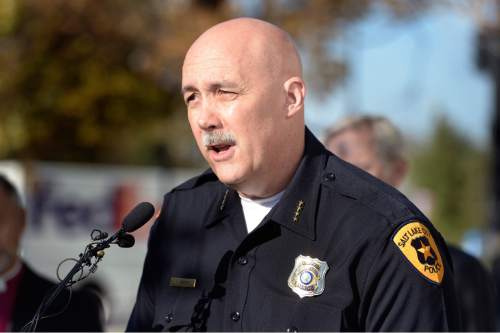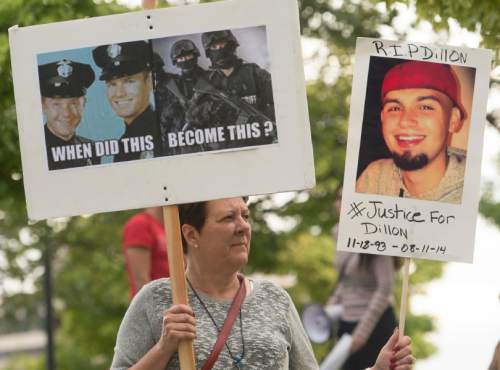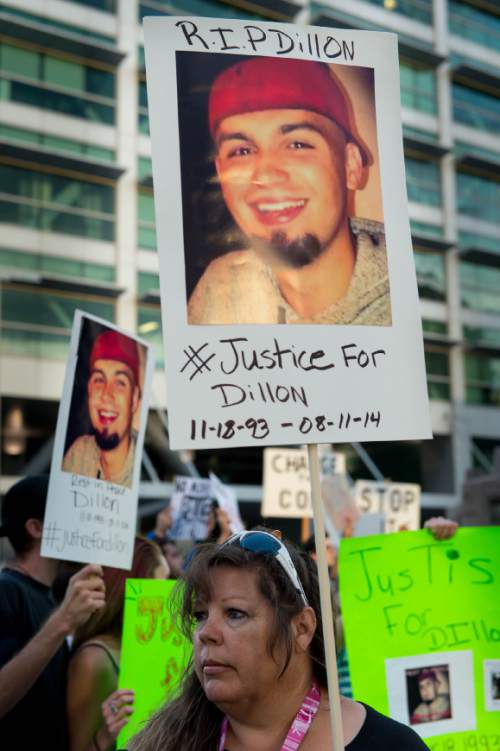This is an archived article that was published on sltrib.com in 2016, and information in the article may be outdated. It is provided only for personal research purposes and may not be reprinted.
The use of lethal force was on the agenda at City Hall on Tuesday as interim Police Chief Mike Brown outlined changes that he said would help officers avoid more shooting deaths.
Although the meeting wasn't meant to be a public hearing, some residents sounded off anyway.
Two of them praised Brown for moving ahead with measures aimed at decreasing fatalities at the hands of law enforcement.
The discussion comes in the wake of the shooting deaths of Dillon Taylor, 20, in August 2014 and James Barker, 42, in January 2015 in Salt Lake City.
The City Council, in its afternoon work session, considered policy measures to improve civilian encounters with police. No vote has been scheduled for policy changes.
Nonetheless, in reaction to the use of lethal force, Salt Lake City police are now taking what they learn on the streets back into the classroom, Brown said. He explained that interactions between civilians and police are very fluid and can change. Officers must be ready for all situations.
The buzzword in police training is de-escalation, said Stan Penfold, council co-chairman.
The shooting death of Barker is a textbook example of an incident that looked to be peaceful but suddenly turned violent as Officer Matthew Taylor pressed Barker for information. Barker had been going door to door, seeking work shoveling snow in his Avenues neighborhood. At one point, he said he offered to go home, but then became infuriated and hit the officer with a snow shovel. The pair wrestled, and Barker was shot. The incident was set in motion after police received a call of a suspicious person in the area.
The Dillon Taylor shooting also occurred after a 911 call. That time, it was a report of a man with a gun at a convenience store near 2100 South and State. Police arrived to find three men in the parking lot. Two of them responded to police commands and raised their hands, but Taylor walked away.
As he did, he put his hands in his sweatpants, leading Officer Bron Cruz to believe he was armed. When Taylor did stop and turn around, he pulled his hands out of his pants and was shot dead. He was not armed.
Both shooting deaths were deemed justified by Salt Lake County District Attorney Sim Gill.
The police chief told the council that while officers spend 6 percent of their time in firearms training, they spend 24 percent of training time on various de-escalation techniques.
"We spend a lot of time training our officers," Brown said. "And we have one of the best-trained departments in the country."
Brown showed the council graphics that he said reveal Salt Lake City has an enviable record when it comes to the use of lethal force.
Communication and understanding a situation are key to de-escalation, the chief said. That is why the department uses "scenario-based training." Salt Lake City police soon will be using a new simulator that produces about 500 different scenarios. The council allocated funding for it last year.
Slowing down potentially difficult encounters is important, Brown said. The chief added that if an officer has cover and can communicate, he can slow things down.
In the Taylor and Barker shootings, neither officer had cover. In the Taylor case, the officer approached the young man, whom he believed to be armed, with no cover, despite the fact that a car was parked nearby.
In his remarks to the council, the chief also emphasized transparency. After every arrest, a watch commander reviews the action of the officer, the chief noted. In addition, officers are required to fill out an incident report. Every controversial police action is reviewed by the department's Internal Affairs Division and by the city's Police Civilian Review Board.
"My goal is to be open and transparent," Brown said.
The chief told the council that transparency could be improved by affording the Police Civilian Review Board independent legal counsel. Presently, the board takes advice from the city attorney.
Resident Susan Barretta told the council that Brown is a breath of fresh air. "It's like night and day," she said, referring to the previous police administration. "It's exciting to hear these developments."
Sharon Burkinshaw of the Community Coalition for Police Reform echoed those comments.
"I'm so happy that you have someone like Chief Brown, who can articulate what needs to be done."
But resident Jacob Jensen said he is concerned the council lacks a mechanism to remove police who use unnecessary lethal force.
"What will this council do to remove police officers after the next murder?"
The council will take up the issue again. A date for continued discussions has yet to be set.







